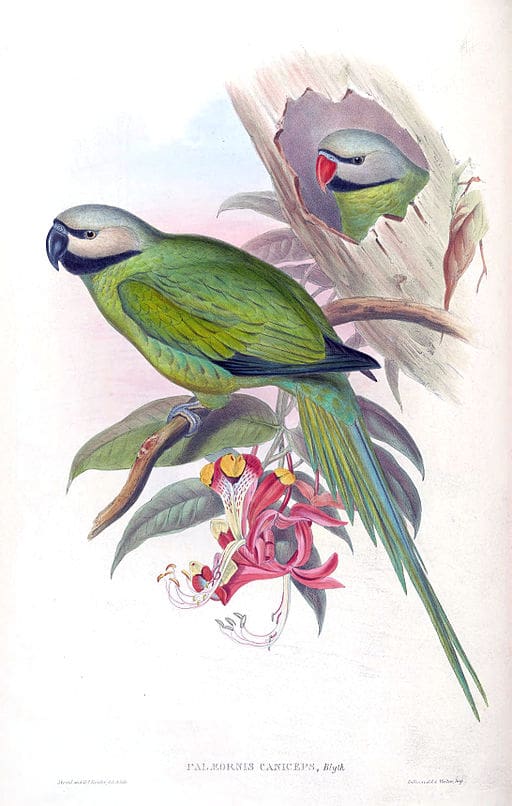Nicobar Parakeet
Also known as:
Blyth's Parakeet, Blyth's Nicobar Parakeet
Also known as:
Blyth's Parakeet, Blyth's Nicobar Parakeet

Psittacula

caniceps
Size:
56 cm (21.8 in)
Weight:
225 g.
Subspecies including nominate:
one
Colour Adult:
Both adults mostly green in colour; mauve/blue tinge to crown and nape in male, more blue in female; black stripe from forehead to area around eyes; black, wide band from chin across lower cheeks; yellow/grey upper cheeks to ear coverts, turning to dull mauve/grey near hindneck; green tail tipped with yellow. Red upper mandible in male, black in female, black lower mandible in both sexes. Eye orange/red.
Colour Juvenile:
Not recorded.
Call:
Calls are described as raucous and crow-like.
More Information:
Content Sources:
CITES
BirdLife International
Cornell Lab of Ornithology/Birds of the World
A Guide to Parrots of the World, Juniper and Parr, 1998
Parrots of the World, Forshaw and Cooper, 1989.
Parrots of the World, Forshaw, 2006.
Lexicon of Parrots, Thomas Arndt.
Captive Status:
Not found in captivity.
Longevity:
—
Housing:
—
Diet:
—
Enrichment:
—
Nest Box Size:
—
Clutch Size:
Possibly 1-2 eggs.
Fledging Age:
—
Hatch Weight:
—
Peak Weight:
—
Weaning Weight:
—
World Population:
6000-15,000 mature individuals, decreasing.
IUCN Red List Status:
Near Threatened
CITES Listing:
Appendix II
Threat Summary:
Not globally threatened. A BirdLife “restricted-range” species. The population is suspected to be declining due to trapping for the cagebird trade and the degradation of its habitat, but the trend has not been directly estimated. Forest loss was measured in the species’ range between 2000 and 2012 at approximately 35 km2. Assuming that forest loss continues at the same rate to the present day, this roughly equates to a rate of forest loss of 7.8% over the last three generations (22.5 years). The tsunami of 2004 may have caused a significant decline in numbers due to the loss of coastal forests. The species may qualify for uplisting in the future should empirical evidence support this.
Range:
Great Nicobar, Little Nicobar, Menshal, and Kondul, in Nicobar Islands, Bay of Bengal.
Habitat:
Found in high rainforest.
Wild Diet:
Feeds on Pandanus fruits; other diet items unknown.
Ecology and Behaviour:
Generally remains sequestered in high canopy, particularly when not feeding. Usually seen in pairs or small groups.
Clutch and Egg Size:
Possibly 1-2 rounded eggs, 38.0 x 25.5 mm (1.5 x 1.0 in).
Breeding Season:
Not recorded.
Related Links:
—

![© John Gould [Public Domain] Wikimedia Commons An illustration depicts Nicobar Parakeets](https://parrots.org/wp-content/uploads/2023/01/wpt_Nicobar-Parakeet_1287-100x100.jpg)